Rare Plane Detective
“sells youth” back to modellers
by Dave Wilson
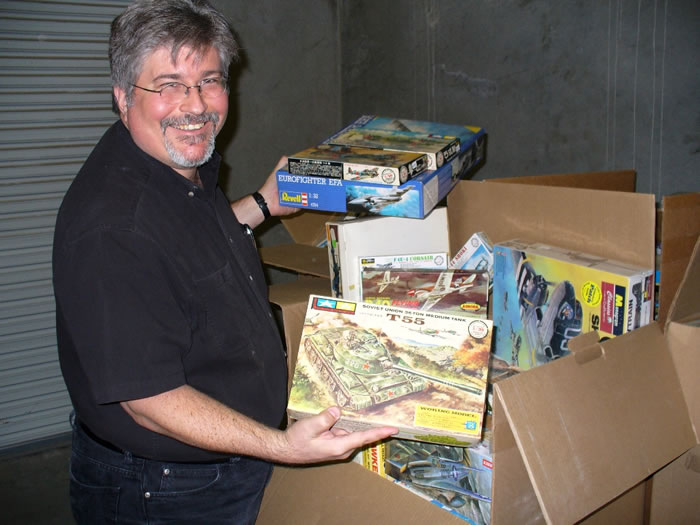
|
Jeff sorts through a box of old kits, with a rare early Tamiya T-55 kit, a prized item for Japanese buyers. |

HyperScale is proudly supported by Squadron.com
On any given day, Jeff Garrity has between 6,000 and 8,000 unmade plastic model kits in his stash - and he has no plans to make any of them.
Although Jeff’s name is well known within the modelling world, with a recognised encyclopaedic knowledge of the hobby and old kitset values, he happily admits he does not make models. The last model kit he assembled was a fish, a salmon he recalls, as part of his daughter’s school project a decade ago.
However name a plastic model aircraft, ship or armour kit and Garrity can give you an instant assessment of it, and its value. What Jeff Garrity does is buy and sell old model kits under his banner, the Rare-Plane Detective.
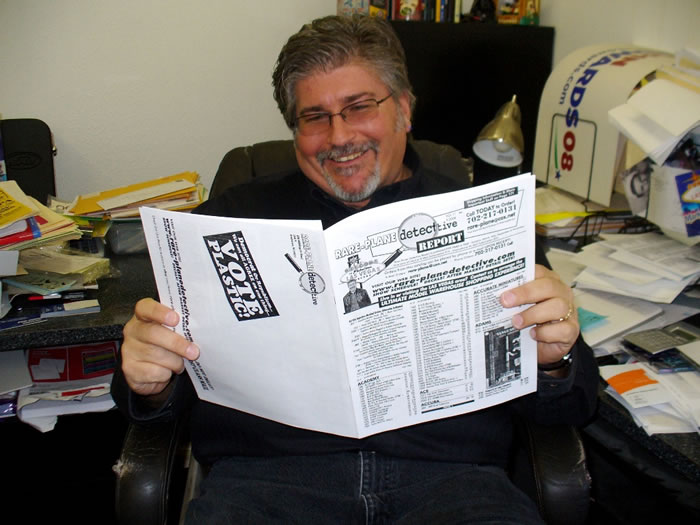
Jeff sorts through his mail order catalogue, the primary sales tool for the Rare-Plane detective. Email, his web site, Ebay and tables at model conventions and shows round out the multi channel market strategy.
Back in the 1980s he was one of the first people to recognise the business potential of recycled kitsets, and regards his business as “selling youth” back to modellers who want to recapture golden memories of their boyhood.
His base is an unpretentious 1600 sq ft warehouse unit in the suburb of Henderson, southwest of the Las Vegas Strip in Nevada. The distinctive glittering shapes of the Vegas casinos dot the horizon a few miles away. But for modellers, the shelves inside unit #5 of 628 Middlegate Road hold the real treasure.
A rack of vintage Revell kits from the 1950s and 60s; original Monogram boxings; Airfix and Frog kits, early Tamiya and brands so obscure they belong to modelling history. Everything in alphabetical order, by company. Every type and scale of model except cars and trucks, which don’t interest him..
Jeff Garrity’s business is based around a compulsion many modellers have, to amass a collection of kits they fully intend to build one day.
“Their eyes are bigger than their bellies. They acquire more kits than they can build, and after a period of time- despite best intentions to “make them all one day” the realisation dawns there are just too many in the stash,” he says.
“There’s always the intention to make them. It works the same as any collecting bug. People acquire these things then realise there’s too many, or they want to sell off the older ones to help buy new kits”.
Collections of multi hundreds of kits are commonplace, while stashes of 2000 to 3000 unmade kits are also not unusual in his business. And often, when he’s bought the collection, the sellers promptly go out and amass another. Not just kits, but also decals and aftermarket sets.
Shortly before HyperScale visited, Jeff had been in Phoenix, picking up a 2000 kit collection plus 2000 decal sheets and 200 aftermarket sets.
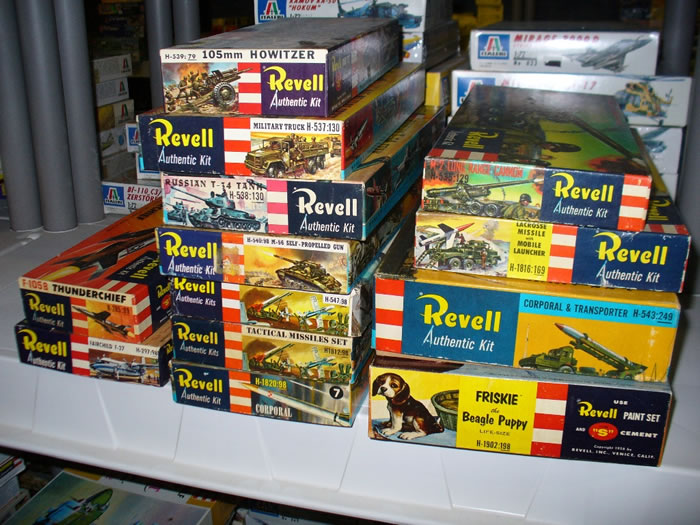
Boxes of memories from the 1950s and 60s
“Sometimes it’s a bit scary, seeing just how bad the addiction can be. I come across lots of spectacularly large collections,” he says. He talks of a customer, a few years back now, who sold a collection of kits so large, he used the money to buy a sporty new car. A few months later he called Garrity again. He had accrued another collection of thousands of kits he wanted to sell.
Jeff cheerfully regards “the three D’s – Death, Divorce and Debt” as the primary reasons he ends up with modellers’ collections.
Garrity is a baby boomer with greying hair, spectacles and a salt and pepper beard. In this regard he resembles a typical modeller these days. He says 80 per cent of the modellers he encounters are in their 50s or older.
He finds it important to stay grounded about the hobby. He does not revere his stock.
“I deal in old kitsets but I’m running a store, not a museum. I don’t want to be sitting on these things. Turnover is what it’s all about”. It helps, he believes, not to be an active modeller in this regard because you can be objective about the kits and how you regard them.
He views old model kits as a fun business - buying collections and recycling the kits via his mail order catalogue, his website, email, Ebay and at various shows and conventions that he attends throughout the year.
In the past four years he has criss-crossed America with his van, notching up almost 200,000 miles on the road, buying up collections and attending model conventions and shows. He has worn out one van and driven almost the equivalent distance to the moon.
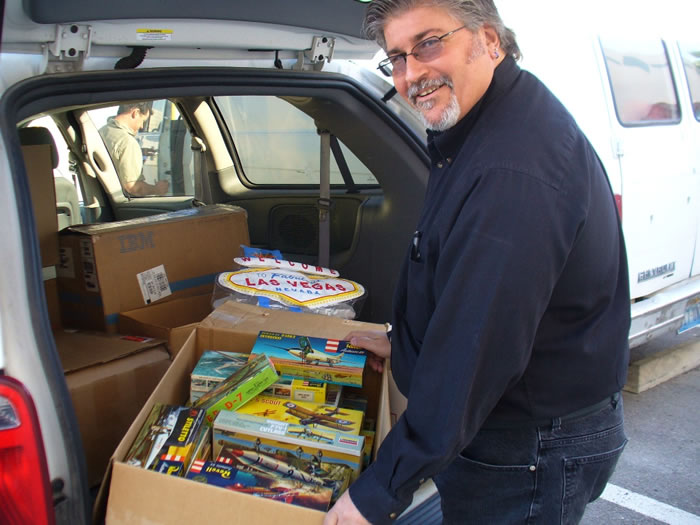
Jeff loads kits into his van for another epic road trip to a model show somewhere in America
A typical week can see him working 13 or more hours a day, seven days a week, yet he loves it and expects it will be the job that sees him out to retirement.
He’s been in the business long enough to survive the highs and lows. The recent Wall Street crash and global economic jitters has impacted on the model kitset world too and he has noticed more calls from modellers wanting to urgently dispose of their collections.
“There’s an average of two calls a day from people wanting to sell their collections for reasons I would link to the current economic downturn.”
He only buys within the United States, purely because the cost of shipping a collection to America, for resale, would chew up any profit. But he eyes the global market as the future for individual kitset sales, especially as the American market hiccups.
“International is the future for model sales for this sort of business, especially as the USA gets “greyer” and modellers here dispose of their 1/72 collections because of age and eyesight issues.”
The mail order corner of his annexe holds parcels ready to go out to destinations such as Costa Rica, Germany, Britain, Ireland, Russia, Spain and Australia.
He’s noticed a trend for modellers in different countries to pursue early kits from their indigenous model manufacturers. The Japanese buyers chase early Tamiya and Hasegawa and will pay big dollars for the earliest examples. Americans want Monogram , Lindberg and Revell and the like, the British are after Airfix and Frog and so on.
“Everyone wants to buy their youth again.”
Serious collectors will pay big money for their Holy Grail kit.
“The ITC Thor Missile Base kit is so rare, if you see one, just buy it because you’re unlikely to see another one. It is currently fetching $2500 and the value is going up,” he says.
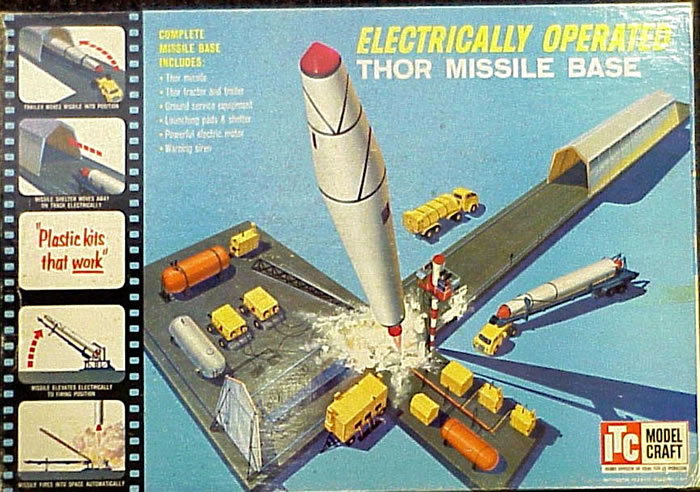
The ITC Thor Missile Base - worth $2500 and rising.
However an old model kit is not necessarily a valuable kit.
“I’ve had people want to sell me old Airfix kits which they think are rare and valuable and I say are not worth anything because the moulds are still in production. Old is not always rare, sometimes it’s just old,” he says.
He diplomatically deflects any move to be drawn into the issue of “ modellers” versus “ collectors”.
“Everyone plans to build their kits. It’s just that sometimes the collecting outstrips the building and so they amass big collections.
Determining a price for an old kitset can be a tricky business. How do you decide the value of something that sold for a few cents back in the 60s, but might command big dollars today? Or not?
“I use my experience to determine price. I know what I can get for a model, and I ask myself if I need this kit for my stock? Modellers often regard any old kit as “rare”, the most over-used word in the kit selling world. I ask myself: Do I need it? No matter how rare it might be, do I need a third or fourth example of it?”
Las Vegas is a long way from the early days of the Rare-Plane Detective. Back in the 1970s he dealt in comic books.
One day in the early 80s he bought a collection of 1940s vintage magazines at a flea market and wondered how to sell them?
Someone mentioned there was a model show coming up, so he took a table at the show and noticed there was no structure to how people sold old kits. An idea formed. What if you could sell old models using the same catalogue and value system used to sell old comic books?
An advertisement seeking model collections yielded his first booty- a 1500 kit collection – good stuff from the 1950s and early 60s - and Rare-Plane Detective was off and running.
Rare-Plane itself went on the shelf in 1990 as Jeff moved on to work in advertising, the printing industry and human resources. But around 2000 an acquaintance from the model days asked if he’d like to create an old kit catalogue.
In the way that these things work, Rare-Plane Detective was soon back on the job and Jeff has no intentions this side of retirement to leave it.
“I enjoy my job, I enjoy my customers. There are others in the same business but we are not cut throat competitors. I don’t handle cars and trucks because they don’t interest me, so in that regard I’m no competition to others,” he says.
Rare-Plane Detective grew in Gulfport, Mississippi but in October 2006 the operation moved to Las Vegas where Jeff’s wife Kathy worked in the corporate relations area of the MGM/ Mirage Group. Kathy’s job fell victim to corporate downsizing earlier this year and at present she is helping Jeff in the warehouse.
One job she patiently attends to is wiping dust from 2000 little plastic bags of Aeroclub white metal parts.
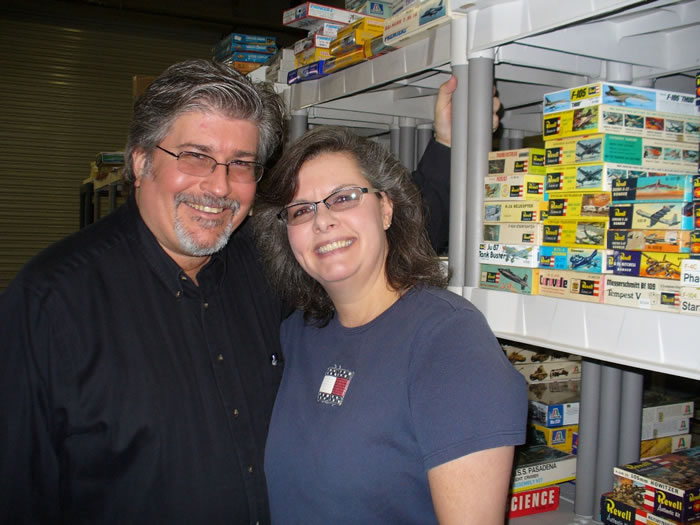
Jeff and Kathy Garrity - Mr and Mrs Rare-Plane Detective
“Dust is our biggest enemy in Las Vegas” Jeff says. “It gets on to everything. We have to wipe and clean down every kit we get”.
Dust, and an economic downturn have clouded the business market a little.
“Back in the 80s a recession was good because it made people build models which made them feel good. Now, with the banks, the stock markets, the global tightening, gas ( petrol) prices…. I’m seeing business is down at the model shows, it’s a more difficult environment.
“But the hobby is still in good heart. My prices are a good alternative to new kit prices, maybe 40 to 50% of newer kit prices and in tight economic times that’s an advantage.
He funds all purchases from his own pocket and expects to spend between $US60,000 to $US70,000 this year on buying model collections.
“I know what a kit is worth by what I know I can get for it. I have had people with 200 to 300 kits who want $10,000 for their models, because they think they are worth gold.
“The nature of what I see evolves too. Over the years I see less of the 1950s stuff and more of the 1960s to 1980s kits. However it’s unusual for brand new kits to get into my food chain. Generally the guys who sell to me stopped buying kits five years ago.”
A major trend in the business is the wholesale disposal by middle aged modellers of 1/72 scale models. Eyesight and aging issues dictate the decision.
“The older guys are moving to 48th and 1/32nd scale so they want to unload their 72 scale stuff and sometimes supply outweighs demand,” he says. Britain and Europe still fly the 1/72 flag, hence the push for international mail order sales to also pick up the slack from an American downturn.
“International is the future for a business like this.
“Internationally the model kitset companies, despite what people say, are in good heart. The Tamigawa guys have a good base for their products and the sales are still there. Modellers just don’t realise how good they have it right now. The quality of new kits, the variety- it was unimagined back in the 60s and 70s.
Jeff is doing his bit for the industry too. This year the Rare- Plane Detective sponsored two specialist decal sheets issued to mark the 2008 US IPMS Nationals.
“I think one of the reasons people buy old kits from me is to not only recapture their youth but also recapture that memory of when modelling was just fun. Some people treat it way too seriously now. Modelling should just be about fun”.
Model,
Text Copyright © 2008 by Dave Wilson
Page Created 7 October, 2008
Last Updated 7 October, 2008
Back to HyperScale
Main Page |
Home
| What's New |
Features |
Gallery |
Reviews |
Reference |
Forum |
Search